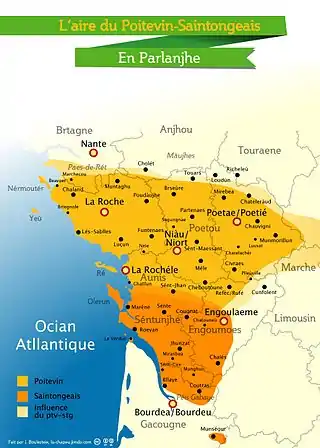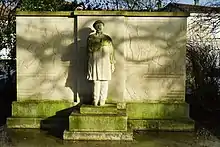Poitevin-Saintongeais
Poitevin-Saintongeais (French: poitevin-saintongeais, pronounced [pwatvɛ̃ sɛ̃tɔ̃ʒɛ]; autonym: poetevin-séntunjhaes;[3] also called Parlanjhe, Aguiain or even Aguiainais in French) is a langue d'oïl language spoken in the regions of the Pays de la Loire and Nouvelle-Aquitaine, officially recognised by the French Ministry of Culture as a language with two dialects, Poitevin and Saintongeais.[4] This classification is a subgroup of the Romance, and the Gallo-Romance languages.
| Poitevin-Saintongeais | |
|---|---|
| poetevin-séntunjhaes | |
| Native to | France |
| Region | Pays de la Loire Nouvelle-Aquitaine |
Native speakers | 200,000–300,000 (2017)[1] |
Early forms | |
| Dialects | |
| Language codes | |
| ISO 639-3 | roa-poi |
| Glottolog | poit1240 Poitevinsant1407 Santongeais |
| Linguasphere | 51-AAA-ha |
 The Poitevin-Saintongeais-speaking area | |

Some of their descendants would become the Acadian people of Atlantic Canada as well as the Cajun people of Louisiana.
The dialects of this language are peculiar to the historical regions and provinces of Poitou and Saintonge. It is classified as severely endangered by UNESCO.[5]
References
- Delavaud, Jean (4 March 2017). "Langues régionales. Une journée pour parler le poitevin-saintongeais" [Regional languages. A day to speak Poitevin-Saintongeais]. Ouest-France (in French). Archived from the original on 26 September 2021. Retrieved 19 September 2021.
- Hammarström, Harald; Forkel, Robert; Haspelmath, Martin; Bank, Sebastian (24 May 2022). "Oil". Glottolog. Max Planck Institute for Evolutionary Anthropology. Archived from the original on 8 October 2022. Retrieved 7 October 2022.
- Produccions, Tirabol (13 August 2012). "Lo peitavin-santongés, una lenga sòrre e emergenta". Jornalet (in Occitan). Archived from the original on 5 September 2017. Retrieved 1 April 2018.
- "Langues régionales" (in French). Ministère de la Culture. Archived from the original on 1 April 2018. Retrieved 1 April 2018.
- "UNESCO Atlas of the World's Languages in danger". UNESCO. Archived from the original on 7 May 2017. Retrieved 1 April 2018.